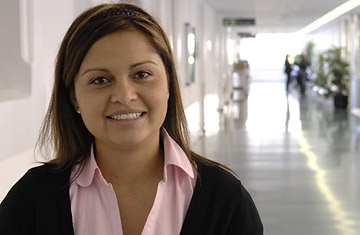
Claudia Castillo at the Hospital clinic of Barcelona after her operation of the Lancet trachea graft
The human immune system will attack anything foreign that enters the body, including transplanted organs. That is why powerful and sometimes life-threatening drugs that suppress the immune system have always been imperative to prevent the rejection of new organs. That is, until now: the British medical journal The Lancet today lays out the first successful trachea transplant, which was also — and more importantly — the first tissue transplant to use stem cells and thus do away with immunosuppressive therapy.
The procedure's success, the result of collaboration by scientists across Europe, opens up a world of possibilities for "personalized" transplants that use recipient's stem cells and, as a result, require no immunosuppressive therapy. (See TIME's A-Z Health Guide.)
"It's a very important demonstration that if different branches of science put together their forces, they can help people," says Professor Paolo Macchiarini, principle author of the study and head of thoracic surgery at Hospital Clinic of Barcelona, where the surgery was performed.
The recipient of the transplant surgery, which took place in June, is Claudia Lorena Castillo Sánchez, a 30-year-old Colombian mother of two who lives in Barcelona. A cough she developed in 2004 was later diagnosed as tuberculosis, and by March of this year, her condition worsened to the point where one bronchus — the extension of the trachea that connects to the lung itself — was blocked. The only possible conventional treatment was to remove one of her lungs, a procedure that would have dramatically impaired her quality of life.
Doctors tend not to recommend trachea transplants because the windpipe is one of the body's organs most prone to rejection. But because of Sánchez's unique situation — she was young and had a rare kind of tracheal damage — Spanish medical authorities granted special permission to Macchiarini and his team to go ahead with an experimental treatment.
The revolutionary technique consisted of scientists creating a hybrid of donor tissue combined with tissue generated from Sánchez's stem cells, which were drawn from her bone marrow. They took a donor trachea, stripped it of the cells that would cause rejection, and replaced them with Sánchez's own cells. The team of researchers was composed of scientists from the University of Barcelona, Britain's University of Bristol, and, in Italy, the University of Padua and Milan's Polytechnic. (See TIME's Pictures of the Week.)
Five months later, Sánchez is in excellent health, without the help of any immunosuppressive drugs. She is able to work, take care of her children and even reportedly go dancing. She's happy, and so are many scientists.
"[This procedure] challenges the idea that if you take foreign tissue it will end up being rejected," says Professor Steven Sacks, director of the Medical Research Council Centre for Transplantation in London, where he leads research on human-to-human transplants. "The potential has been open for a while, but this gives a living example that it can actually succeed."
Though there are two other patients in Spain awaiting similar treatment, scientists are quick to point out that "personalized" organ transplants will not be widely available for at least several years. One reason for that is that most countries' medical regulations don't yet open an easy path to such procedures, which remain experimental. The team of scientists plans to engineer a hybrid larynx as their next project, which may take a few years, according to stem-cell specialist Professor Anthony Hollander of the University of Bristol. Reconstructing large, complex organs such as the heart and the liver will be more difficult, he says, not to mention expensive.
The broader application of the procedure will depend on making it less expensive. One way to do that, says Hollander: developing automatic processes, rather than the labor-intensive techniques applied this time, for generating tissue from the patient's own stem cells. Once scientists are able to engineer similar transformations of other organs to save lives and spare the side effects of immunosuppressive drugs, "This would be beautiful," says Macchiarini.
